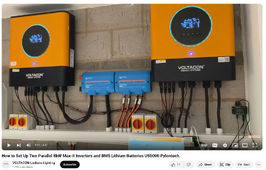sunshine_eggo
Happy Breffast!
My uncalibrated eye measures about 4' more cable in the total round trip. That would make the voltage drop difference about .05V. Not enough to worry about and probably far less than voltage drops on the fuses, connectors, etc. Even if you double the calculated drop and call it .1V, it is not enough to worry about.
I generally don't argue with you, but I definitely disagree this time. Sig link #6, 4.9.



